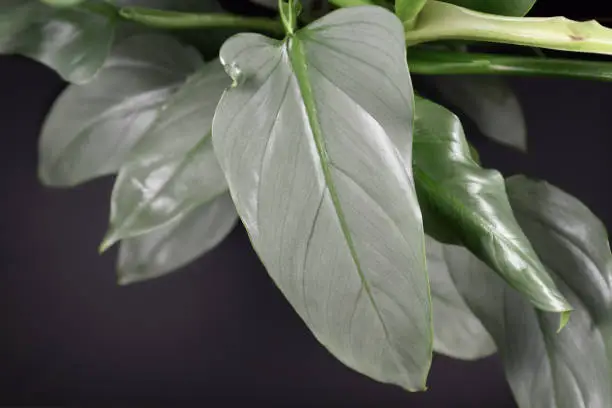The “Silver Sword Philodendron” botanically named Philodendron hastatum ‘Silver Sword,’ is a captivating tropical plant in tropical rainforests. Its striking appearance features sword-shaped leaves with a shimmering silver-blue hue and vibrant green stems. This fast-growing Philodendron is a good option for planting. However, this plant is known for its brags thick stems, and rapid growth rate. In its natural environment, it flourishes in bright light.
Philodendron hastatum Grey exhibits a robust climbing nature characterized by its elongated, glossy leaves. Moreover, originating from South America, this specie exhibits leaf color ranging from pale gray to dark green, evolving into a striking metallic gray or bluish silver as it matures.
Read and Compare: Types of Philodendron: Exploring Diverse Varieties

Silver Sword philodendron cultivation information
| Aspect | Information |
| Space area required to plant | 10 – 15 cm (4-6 Inches). |
| Plant height | Varies based on starting size/growth |
| Plant Type | Climbing/trailing tropical plant |
| USDA Hardiness Zone | Depending on the variety and outdoor location usually from 9-11. [1]Salient features of Philodendron hastatum. Read |
| Cultivation period | Year-round (indoor), in the warmer months (outdoors). |
| Ideal cultivation temperature | 65-75°F (18-24°C) |
Salient Features of the Silver Sword Philodendron
The Silver Sword Philodendron, also known by its scientific name Philodendron Hastatum, is a member of the Araceae family. The most notable feature of this Philodendron species is its silver-hued, sword-shaped leaves. The leaves are elongated and have a smooth, glossy texture. The petioles, the leaf stalks that attach the leaves to the stems, are bright green, creating an attractive contrast against the silver-blue hue.
This Philodendron has a strong climbing habit and can grow as a vine if provided with the support of a moss pole or trellis. The Silver Philodendron species are relatively fast-growing, mainly when provided with appropriate care and conditions. Adding this plant to your indoor garden will create a statement piece growing to three feet tall.
The leaves start with a pale grey or dark green, gradually maturing into a striking metallic grey or bluish-silver. However, the leaves can grow substantially, contributing to the plant’s bold and eye-catching appearance.

Read: Rhaphidophora Hayi – Shingle Plant
Care and Maintenance Required for the Silver Philodendron hastatum
The Philodendron species requires proper care and maintenance to thrive. However, your Silver Philodendron species will remain healthy and vibrant if you follow these care tips.[2] Silver Philodendron hastatum Care Information. Read
Light – The Philodendron thrives in bright, indirect daylight, preferably near east-facing windows. Direct sunlight can burn the leaves, so avoiding placing them in harsh sun exposure is essential.
- You can also position it away from south or west-facing windows to prevent direct sun exposure. Therefore, the variegation on its leaves suggests it thrives in well-lit conditions.
Watering – This Philodendron species prefers to be kept evenly moist but not soggy. Ensure that excess water drains out of the pot after watering the plant. However, ensuring the plant is not settling at the bottom is equally necessary, as this can damage the roots.
Humidity – The Philodendron is a tropical plant that thrives in high humidity. Meanwhile, adding humidity to the plant is easy by misting the leaves or placing the plant in a tray filled with water.
Fertilization – This Silver Philodendron species benefits from regular fertilization during the growing season. However, it is possible to provide nutrients to the plant by applying a balanced liquid fertilizer every month.

Plant Calendar of Silver Sword Philodendron
| Season | Months | Tasks to do |
| Spring | March-May | – Start fertilizing with a balanced liquid fertilizer – Watch for pests and treat them if needed – Continue growth monitoring |
| Summer | June-August | – Protect plants from direct daylight – Maintain humidity. However, mist or use a humidity tray – Continue regular fertilization – Pruning to maintain shape and size |
| Fall | September-November | – Reduce watering frequency as temperatures cool – Maintaining humidity levels |
| Winter | December-February | – Check plant health; remove dead or yellowing leaves – Prune imbalanced growth to a manageable size – Adjust the plant’s position for proper light |
Propagating the Silver Sword Philodendron
Propagating this Philodendron species is a rewarding experience allowing you to expand your collection. There are several methods of propagation that you can choose from. Here is the discussion on stem-cutting[3]Propagating Philodendron hastatum. Read techniques;
Stem Cuttings – To propagate using stem cuttings, cut a healthy stem just 1 inch below a node and place it in a glass of water or directly in moist soil. However, the cutting should be 4-6 inches long and have at least one or two leaves attached. Trim away the lower leaves, leaving at least one or two leaves at the top of the cutting. Hence, it reduces moisture loss and encourages the development of new roots.
Read: Curly Spider Plant Propagation, Care, and Diseases
If propagating it into the soil, ensure the cut end of the stem is in the hole, ensuring that at least one node is beneath the surface. Keep the pot in bright, indirect daylight. Therefore, avoid direct sunlight as it can stress the cuttings. However, once the cutting has developed a sound root system, usually after a couple of months, you can re-plant it into a larger pot with regular care routines.

Common Pitfalls with the Silver Sword Philodendron
Like any other plant, this Philodendron species is susceptible to certain pests and diseases. Here are some common issues you may encounter and how to address them:
- Spider Mites – These can cause damage the leaves. However, to combat spider mites, regularly mist the leaves and pour the soap or neem oil around the plant in a circle; it should be entirely away from the root system.
- Mealybugs – Mealybugs are insects that can infest the leaves and stems. Meanwhile, to combat mealybugs, use soap and remove them manually.
Maintaining your Silver Sword Philodendron’s health and vigor requires being vigilant and addressing pest and disease issues promptly.
Is the Philodendron toxic to pets?
The Silver Philodendron species are toxic to household companions[4]Silver Sword Philodendron Toxicity. Read. However, It is essential to keep the plant out of reach of pets to prevent ingestion.
Silver Sword Philodendron (Philodendron hastatum ‘Silver Sword’) is considered toxic to pets, especially cats and dogs. Calcium oxalate crystals are present in the plant, which can cause irritation and discomfort when orally consumed. When pets chew on or eat parts of the plant, it can lead to symptoms such as vomiting, mouth irritation, and difficulty swallowing.

If you suspect that your pet has ingested any part of a Silver Philodendron species or any other potentially toxic plant, it’s recommended to contact your veterinarian immediately for guidance.
Read: Dangers of ZZ Plants to Cats
The Philodendron purifies the air.
The unique coloration sets it apart from other philodendron varieties, adding an exotic and modern touch to your indoor space.
Air-Purifying Qualities – Like many other philodendron species, the Silver Philodendron species can help improve indoor air quality by filtering out pollutants and toxins from the air. However, Formaldehyde can be easily eliminated from indoor spaces by using this product. Especially from paints, roofing materials, and adhesives, it excels at eliminating formaldehyde to about 99%.[5]Korostenskij, I., Propagation, upkeep, and impact on mental health and classroom/workplace success of Dracaena trifasciata, Chlorophytum comosum, and Philodendron hederaceum. 2021. Read
Concluding thoughts
Philodendron hastatum ‘Silver Sword,’ also called Silver Sword Philodendron, brings beauty with its vibrant silvery-green hue and growth pattern. This Philodendron species has easy care requirements, and its stunning appearance makes it a standout choice for any indoor interior.
References
| ↑1 | Salient features of Philodendron hastatum. Read |
|---|---|
| ↑2 | Silver Philodendron hastatum Care Information. Read |
| ↑3 | Propagating Philodendron hastatum. Read |
| ↑4 | Silver Sword Philodendron Toxicity. Read |
| ↑5 | Korostenskij, I., Propagation, upkeep, and impact on mental health and classroom/workplace success of Dracaena trifasciata, Chlorophytum comosum, and Philodendron hederaceum. 2021. Read |



